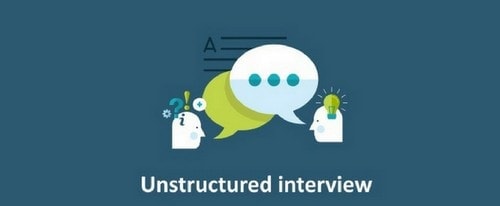The purpose of the qualitative research interview is to study the experiences, views, or belief of an individual on a specific subject or topic. In qualitative research methods, interviews help you to get a deeper understanding of social trends as compared to the data collected using quantitative methods such as questionnaires.
Therefore, interviews are appropriate in those scenarios where you have basic knowledge about the research topic and you want to establish a deeper understanding of it. Interviews can also be used to conduct information about such topics where the respondent is very shy or does not feel comfortable to talk about it among a group of people.
For example, if you want to collect data about the “psychological process involved in regular health check-ups”. There could be various reasons behind this such as some people don’t feel like sharing information in front of others. In this article ahead you will learn about the different types of interviews conducted in qualitative research.
Table of Contents
1) Interviews :
There are three types of interviews which are used to gather data in qualitative research such as structured interviews, semi-structured interviews, and unstructured interviews.
i) Structured Interviews :
Structured interviews are kind of verbally presented questionnaire. In structured interviews, a list of pre-determined questions is asked to the respondent. The questions are not altered during the interview and no follow-up questions are asked to get an explanation on a given answer. These interviews can be conducted fast because there is almost no chance for both interviewer and respondent to get deviated from the topic. The responses can be compared and analyzed easily because of the uniformity of the questions asked.
However, a little bit explanation can be provided to the respondents in case they require your help to answer a question better. You need to prepare questions in such a way so that they will get you maximum information. Therefore, preparing questions for structured interviews is a long and difficult process. only a limited number of respondents can be interviewed by the use of structured interview method.
ii) Unstructured Interviews :
On the other hand, unstructured interviews are conducted with a little or no preparation. Unstructured interviews are kind of regular conversation between two people. Unstructured interviews can begin with an opening question like “Can you tell me about your experience visit a retail store?” and then the interview will progress by asking questions on the basis of the response of the first question.
These interviews also require your skills to form questions in such a way so that they will get you a detailed response. Let us understand this with the help of our first example “Can you tell me about your experience visit the retail store?”. This question is formed in such a way that it will stimulate the respondent to answer it in deep detail. However, the same question formed in “How was your experience of visiting the retail store?”.
The respondent will answer this question by simply saying “good or bad”. Though you will get your answer, you will not learn anything from it. hence, you will miss the purpose of your interview. therefore, a person who conducts unstructured interviews must know how to ask questions so that they will get him a detailed response. In addition to this, you should have a good presence of mind to form questions on the spot.
Unstructured interviews are very time-consuming and they usually last for long hours and they are difficult to participate in and manage, because of the lack of pre-determined questions list. Unstructured interviews are suitable for those researches where the interviewer has little or almost no-knowledge about the research topic or researcher want to get information about a topic from a different perspective.
iii) Semi-Structured Interviews :
Semi-structured interviews are a combination of both structured and unstructured interviews such as, a researcher will come up with a list of questions to be asked in the interview, but he can also ask follow-up questions to get deeper detail or explanation from the respondent on the basis of his response. This type of interviews is mostly used for research in the health care industry, where interviewer provide guidance to participants on what they should talk about. This helps the participant to provide accurate information.
The flexibility of unstructured interviews and preparation of structured interviews make this interview type a suitable option for qualitative research purpose.
It is important to design interviews in such a way so that they will yield as much information about the research topic as possible and also don’t abandon the purpose of research. In qualitative research, questions should be open-ended (that means they should provide you answer more than Yes or No), understandable, and sensitive in nature.
you should start interviews with questions that people feel comfortable to talk about rather than the sensitive or difficult to answer questions. by doing this, you can make your respondent feel comfortable, build-up their confidence so that they will provide you quality data which will help you to extend your interview further.
It is advisable for research to test schedule on a few respondents before starting proper data collection. This will help you to establish if your questions are clear, understandable, and will provide an answer as you have expected. The length of qualitative research interviews varies from topic to -topic. The ideal length of the interview is usually between 30-60 minutes. If required interviews can be conducted on the same participant repeatedly. In this way, you will get rich-data which will enhance the quality of your research.
Inform your participants and take their consent a few days prior to the schedule of interview. This will save your time, in case, your participation is not available on the day of the interview. In addition to this, you should also tell them about the ethical principle such as confidentiality and anonymity. In this way, your participants can prepare and be aware of questions to be asked in the interview and if they are assured of ethical principles, they will give you honest answers.
An interview must be conducted at a place where there are no distractions and also the respondent feels comfortable. Usually, most respondents prefer their home in the evening. The respondent will feel relaxed and easy at the comfort of there home and this can assure you a productive interview. An interviewer must remain calm and composed during the interview. he should have skills to ask questions in such a way that they should come naturally and should not look rehearsed. Along with this, he should be patient enough to listen to the respondent without interrupting.
An interviewer must adopt neutral body language, smiling face, and make encouraging sounds to acknowledge the respondents. Don’t hesitate to ask for more details or explanation If there is something that you did not understand properly or found confusing. At the end of the interview, thanks to your respondents for their time and participation and ask them if they want to add more.
This can prompt them to tell things that you skipped to ask through questions or they did not tell you. besides this, you should also provide a brief description of your study to respondents after the interview has finished. You must record all your interviews. in this way, you will get recorded permanent records and don’t procrastinate to make notes about various thoughts or ideas you got during the interview. otherwise, there are chances that you might forget them.
2) Focus Group :
Focus Group has many features same as semi-structured interviews. A selected group of people carries out a group discussion on the topic of research. A researcher guides, monitors, and record the whole group discussion. This technique is mostly used when a collective view of people is required on a particular research topic. A researcher should compose a focus group with great care.
The effectiveness of the Focus Group depends on the participants of the group. The success of the Focus Group depends on how well the participants interact with one another. There is no best method to compose a Focus Group to get useful data. Sometimes participants who are familiar with other members of the group are better to pull of discussion and sometimes total strangers’ groups turns out to be good.
For example, in the field of health, people can share their health-related issues comfortably with the group and in other fields, people might speak freely without the free of repercussions, hence, you can collect rich data for your research. The performance of a Focus Group also largely affected by the number of participants in the group. It is advisable to over-recruit and manages a little large group than canceling a discussion session because of the unsatisfactory results from the discussion of the group. Six to eight members are ideal for Focus Group.
However, a focus group can work well with a minimum of three people and a maximum of 14 people. A small group will not provide you rich data and large groups can be chaotic and each participant might not get sufficient chance to speak. In Focus Group, the opening questions should be more general and later more specific questions should be asked. A researcher should keep the order of questions according to the research agenda.
A researcher should prepare at most twelve questions to be asked in group discussion. However, once the discussion is active, the researcher can probe and ask for more specific details. the place where group discussion will be conducted must be a quiet, free from discussions, accessible, private, and comfortable. Therefore, a researcher must consider all this factor before finalizing a place.
This is all about the different types of interviews include in qualitative research.
Liked this post? Check out the complete series on Market research




very much organised and educative
very educative my research will come good
Semi-structured interviews are useful for any industry, not just healthcare. When conducting unstructured and semi-structured interviews, a great technique to ensure that you don’t miss important questions is to visualize the main areas you want to learn about the interviewee and mentally fill in those areas during the course of the interview.
Regardless of the type of interview, qualitative user research can require significant time and effort, so we created qualitative.io to make it super easy to invite, schedule, and conduct user research sessions.